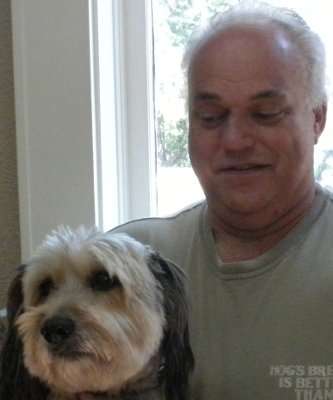We have an 11 year old Lab/Akita/English Bull Mastiff mix male neutered dog. About 8 months ago he started peeing in our utility room right in front of the washer on a throw rug but only at night. He’s 119 lbs so he pees a lot! At first, it wasn’t happening every night but most nights. Now it is nearly every night. We also noticed he would stay at his water bowl for long periods lapping up water, to the point where we couldn’t figure out why. He never peed in the house before, he’s always been a good dog but now he was doing such odd things like getting into the garbage although we have the trash can up high where he can reach it. He would also pull things off the counter in our absence, like an entire loaf of bread and eat it. One morning I woke up to blood all over my house– it looked like a murder scene. My son had thrown away in our recyling container an empty tuna can that had been washed out. Our dog, Rex some how got the tuna can out of the garbage and took it to his bed cushion and licked it and tore it open with his teeth so much that it must have cut his nose and tongue. Then he began in pursuit of water as he had licked his bowl so dry that there was blood in the bottom of it. He went to both bathrooms looking to get water from the toilets but we keep the lids closed, and Rex licked the outside of the toilet bowl– I guess looking for consensation droplets. There was blood drips all over the floors, all over the toilet bowls, the walls, we had to throw away his big bed because it was ruined with blood. There was blood on the floors and on and on. He’s doing unusual things he never did before. He’s always been such a good dog whom we’ve had since he was 6 weeks old, you could have left a steak on the table and he wouldn’t have touched it previously. Of course, we took him to his Veterinarian right away and the doctor did all kinds of tests including a full panel that was sent to the University of Illinois School of Veterinarian Medicine. They found nothing. His doctor said his urine looked very dilute– so he was drinking too much water. We have tried everything with him and he really seems to have a pychological attachment to water. Nothing has changed, his diet is the same, his walking routine is the same, the only thing that has changed has been his attachment to water, and he pees in the same spot on the utiliy room floor and only at night, never during the day. I am going to the pet store today and get him some mind actiity toys and see if possibly this will help. Thanks for all your great comment.s
Sept. 16, 2018
Rex’s Owner
The 33rd Congress of the World Small Animal Veterinary Association Proceedings Online
Welcome to the 2008 WSAVA Congress Proceedings Online (WSAVA 2007).
In August 2008, the World Small Animal Veterinary Association held their 33rd World Congress in Dublin. The notes from these presentations are featured in the WSAVA 2008 Congress online proceedings.
Full text of the proceedings is presented here. The presentations are organized by category for easy access.
Whilst every effort has been made by the editors to see that no inaccurate or misleading data, opinion, or statement appears in these proceedings, they wish to make clear that the editors, publishers, contributors, members of the WSAVA Congress Committee and their employees cannot take responsibility for the consequences of any such inaccurate or misleading data, opinion or statement, including information provided on dosages and methods of application of drugs mentioned herein.
Browsing the Proceedings
When browsing the Proceedings online, you may use the Table Of Contents (Browse By Speaker and Browse By Category), in the left column, or the ‘Previous’ and ‘Next’ arrows found at the top and bottom of each article. The titles displayed in the Table of Contents may be abbreviated. To view a particular article, and the full article title, click the title of the presentation.
When browsing the Proceedings online, you may use the Table Of Contents (Browse By Speaker and Browse By Category), in the left column, or the ‘Previous’ and ‘Next’ arrows found at the top and bottom of each article. The titles displayed in the Table of Contents may be abbreviated. To view a particular article, and the full article title, click the title of the presentation.
Searching the Proceedings
To search the Proceedings by topic, type a specific topic in the ‘Search this Resource’ box and click the ‘Go’ button.
Psychogenic Polydipsia In Dogs
Psychogenic polydipsia(PP) is a syndrome resulting in a patient drinking inappropriately large amounts of fluid. In the case of dogs and cats their fluid intake is usually limited to water.
 Muffie drinks too much water because of psychogenic polydipsia.
Muffie drinks too much water because of psychogenic polydipsia.
Poly is a Latin prefix meaning “many.” Dipsia is a Latin verb meaning “to drink.” Therefore, the polydipsic patient drinks often, or in large quantities, resulting in a 24-hour intake being higher than normal.
Of course, if intake is excessive, output, in the form of urine, will also be excessive, resulting in polyuria. Together they form a condition called polydipsia/polyuria, or pu/pd.
There is a very, very long list of medical abnormalities that can result in polydipsia. Diabetes mellitus,
Diabetes insipidus, Cushing’s Disease, renal failure, hyperthyroidism, liver disease, pyometra and many more.
Today, however, we are going to discuss a cause of pu/pd that is all in the patient’s head. As the name indicates, psychogenic polydipsia results from a thought process in a dog or cat’s psyche, or mind. Something stimulates the patient to want to drink and continue drinking instead of stopping when his thirst is satisfied. Such patients may be “excitable,” “wound too tightly,” or have a nervous personality.
In order for kidneys to work properly (in any species), the renal medulla (medulla is a Latin term meaning “middle”), which contains many structures, must have a solute gradient. To grossly oversimplify the solute gradient, think of a water bath with chemicals in a jar. The chemicals are least concentrated in the top of the jar, with concentration increasing toward the bottom. In order for the structures in the middle of the kidneys to work properly, they must be bathed in this mixture that is appropriately graduated.
In the patient with psychogenic polydipsia, the huge volume of water imbibed causes a constant effort to remove excess fluid from the body so that the bloodstream will stay in proper balance. As the kidneys work overtime to excrete the overabundance as urine, some of the solute in the solute gradient gets removed, too. As the exuberant drinking continues, eventually almost all of the solute is gone and the kidneys cease to have the ability to concentrate urine. This endpoint is called solute washout.
Fortunately, the kidneys know how to fix solute washout all on their own. However, there is an important step that we must perform: limit water intake. In a one-pet household, this is easy. Your pet’s doctor tells you a healthy amount of water for your pet to drink, and you ration it out through the day. Obviously, you can’t put out the entire day’s allowance of water first thing in the morning, or your dog will drink all of it at once, then be dehydrated for the remainder of the day. Allow a third in the morning, a third at lunchtime and the final third when you come home from work. If no one is home during the day you can provide two aliquots, but that’s not as good for your pet.
Alternatively, you might rig a timed pump for his water bowl, dispensing an hourly quantity of water.
Recovery from solute washout is not immediate, but the pet with psychogenic polydipsia will usually improve within a few weeks.
Options are limited if you have more than one pet. If you supply enough water for both, the PP dog will drink it all, leaving the other pet to dehydrate. If you put out an unlimited amount of water, the PP dog will be back to drinking excessively the first day.
Some clients manage. Muffie, pictured above, lives with three other dogs. She drinks, she urinates, and she maintains her housetraining despite the incredible volume of water intake and output. She thrives in spite of the potential for electrolyte imbalance, a tribute to our bodies’ amazing ability to tolerate abuse. Even laboratory testing shows no abnormalities, other than a very, very low specific gravity.
Click to read more about dog diabetes
See you tomorrow, Dr. Randolph.
MMPP



